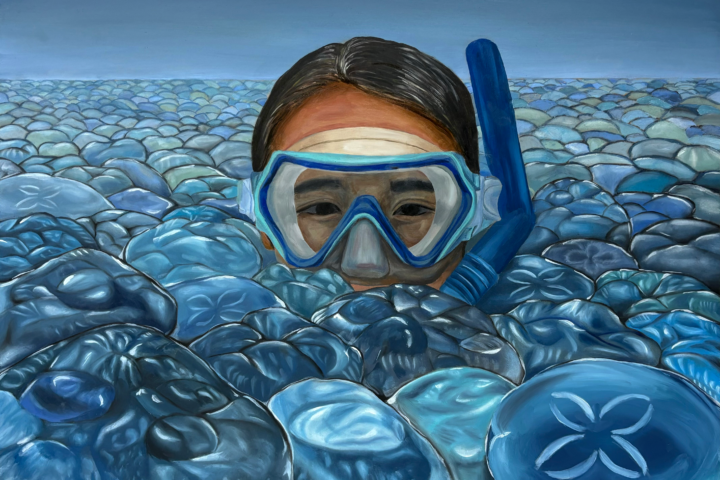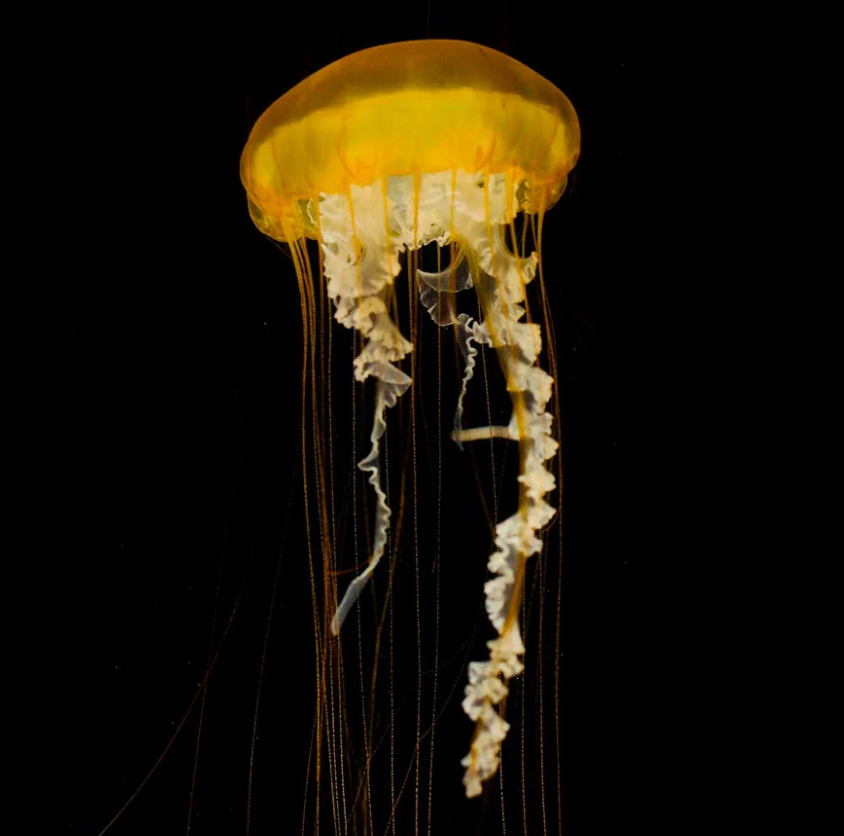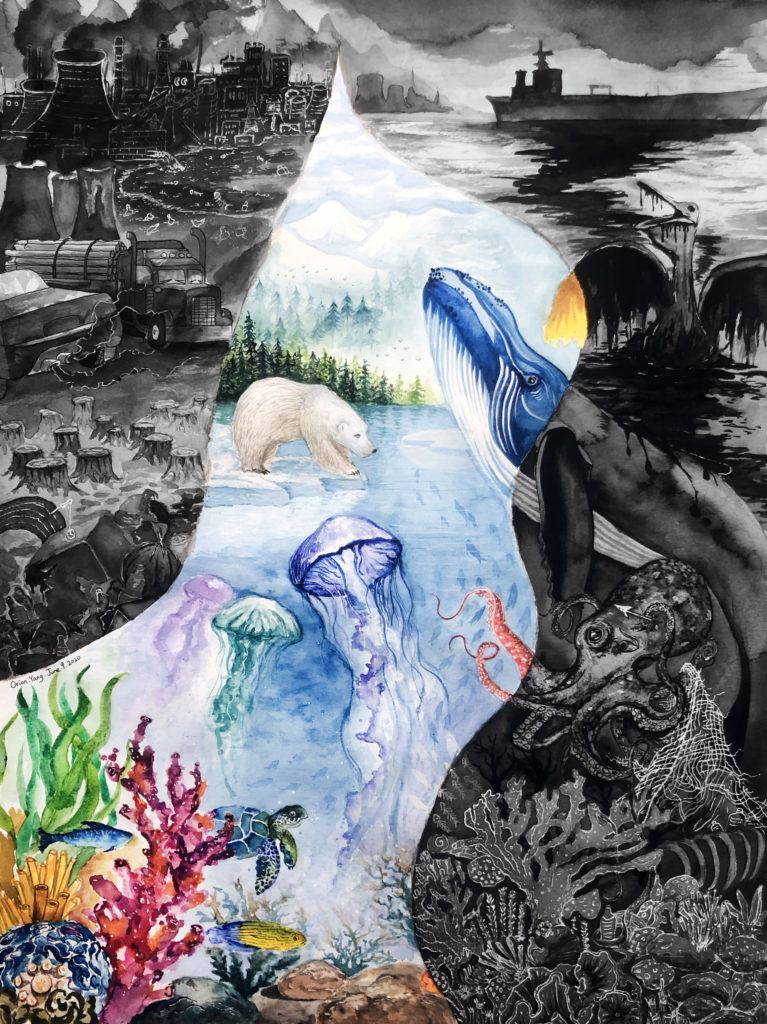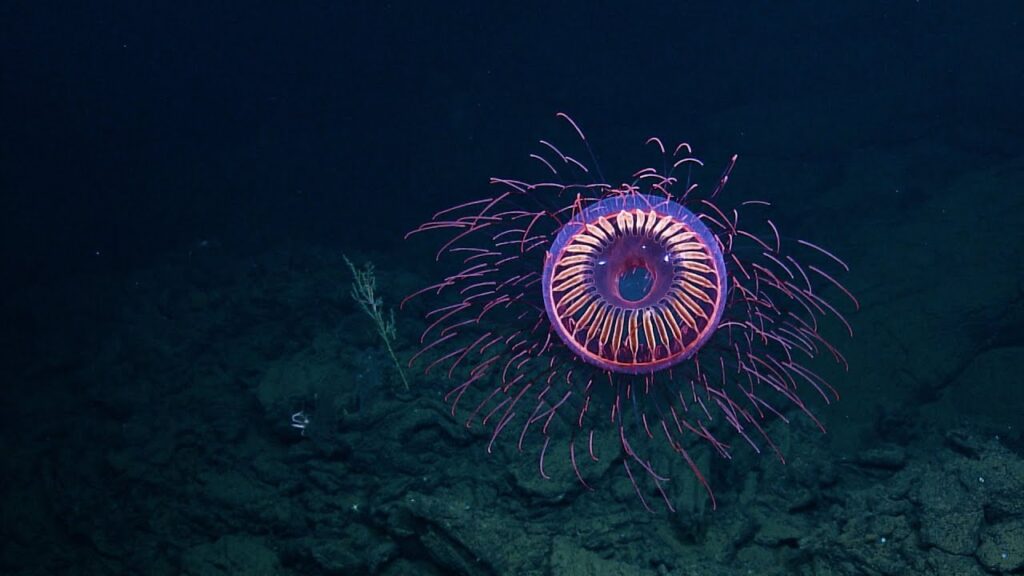
Creatures of Water and Light
March 18, 2025By Nethanya Fonseka, 2025 Future Blue Youth Council member
Cover photo by Hyemin Lyoo (The Tide of Jellyfish, 2024).
Boneless, bloodless, brainless — jellyfish are remarkably simple creatures. These ancient drifters carry history, remedies, and remnants of time with them as they roam the unending blue sea. Although made almost entirely of water, some jellyfish appear to be made of light because of their bioluminescence, which causes them to glow in the sea’s dark depths.1 These incredible creatures of water and light occupy essential places in natural history, mythology, medicine, and marine ecosystems.
Jellyfish have drifted Earth’s oceans for over 600 million years, long before the first fish swam or the first tree grew. They have pulsed through the seas with infinite wisdom and resilience, surviving all five mass extinction events because of their incredible ability to adapt and thrive in a wide range of environmental conditions.2 Although the Cretaceous–Paleogene Extinction (66 million years ago) eliminated 75% of all animal species, jellyfish continued their steadfast drifting, unaffected by the catastrophic environmental changes around them.3
Jellyfish are innately woven into various mythologies. Their ghostly, translucent bodies and venom-laced tentacles have fascinated ancient cultures across the Earth. In Japan, jellyfish are called “kurage (海月),” because jellyfish in the sea looked like the moon reflected in the water.4 There is a famous tale in Japanese folklore that explains why jellyfish have no bones. In this ancient story, the jellyfish had legs, bones, and a shell which enabled it to walk on land as well as swim in the sea. The legend goes that the King called upon a jellyfish to retrieve the liver of a monkey to cure his wife, but when the jellyfish returned empty-handed, the furious King ordered his executioners to “break every bone in his body,” and “beat him to a jelly.”5
In another Japanese myth, the jellyfish was once a symbol of beauty, round and radiant as the moon.6 But the jellyfish was proud and arrogant, boasting about its ability to traverse the world, until a monkey challenged him to prove it. The jellyfish accepted the challenge and swam the sevens seas, visited faraway lands, and explored uncharted territories. However, it soon confronted the harsh realities of the world, withered, and lost its bones.7 The moral of the story still echoes through Japanese culture today: pride leads to irreversible consequences.
 Sea Nettle, photo by Citrus Reef
Sea Nettle, photo by Citrus Reef
For Aboriginal people, jellyfish are associated with much happier things. Aboriginal people believe jellyfish, with their ethereal appearance and movements, are connected to the spiritual realm.8 Aboriginal communities believe jellyfish can cleanse the waters and safeguard both the environment and the people. Aboriginal people have also practiced sustainable fishing for thousands of years, in part due to their understanding of marine life, especially jellyfish.9
Researchers have been studying various animal venoms to determine if their unique biological traits can be used in medicine. Traditional medicine, namely in Asia and Africa, has used venom to treat diseases for centuries. Cobra venom has been used in Ayurveda, an ancient system of medicine with roots in India, to treat joint pain, inflammation, and arthritis.10 Bee venom has been used to treat chronic inflammation and skin diseases for thousands of years.11 Now, studies show that venoms of cnidarians (e.g coral, jellyfish, and sea anemones) are abundant sources of enzymes and toxins that can potentially be developed into medicine for treating diseases.12 These toxins are being studied in hopes to gain insight into their potential ability to be used specifically as antioxidants and anticancer agents.13
Jellyfish help to keep our seas teeming with life. As they drift through the different layers of the water column, jellyfish transport nutrients like nitrogen and phosphorus through the ocean.14 These nutrients are then cycled and used by other organisms for growth and survival. For example, almost a quarter of the phosphate requirements needed for the growth of phytoplankton are fulfilled solely through jellyfish excretion.15 In this unseen exchange of nutrients, jellyfish help to sustain the life around them and support the growth and survival of countless marine organisms.
 A Glimmer of Hope by Orion Yang, 2020
A Glimmer of Hope by Orion Yang, 2020
Jellyfish are also protectors and providers, offering a safe habitat for juvenile fish to grow shielded from predators. Juvenile fish from about 80 species form symbiotic relationships with jellyfish, including commercially-important fish like pollock, jacks, and trevallies that find shelter under the tentacles of jellyfish.16 This strengthens the ecosystem by supporting the survival of juvenile fish, which also benefits human populations by sustaining fish stocks and commercial fisheries.
Jellyfish also serve as a vital food source for one of the most vulnerable animals on the planet: the Loggerhead Sea Turtle. Kelly Stewart, a researcher with the National Oceanic and Atmospheric Administration, reveals that, “jellyfish, and any gelatinous species, are the preferred food source for leatherback sea turtles,” meaning that if loggerhead turtles have a plentiful food source of jellyfish, that helps the females reproduce more often and keep the population stable.17
The immortal jellyfish (Turritopsis dohrnii) has the extraordinary ability to “rewind” its biological clock by reverting to an earlier stage of development. The Natural History Museum states that this process, called transdifferentiation, “essentially reprograms the adult jellyfish’s specialized cells to become specialized polyp cells.”18 This allows the jellyfish to regrow itself into an entirely different body than it had formerly been in. This life cycle reversal can be repeated over and over again, and in perfect conditions, this jellyfish would never die of old age.19 The immortal jellyfish’s ability to rewrite the rules of death challenges us to reconsider our understandings of biology, aging, and life itself.
 Halitrephes maasi, photo by E/V Nautilus
Halitrephes maasi, photo by E/V Nautilus
Jellyfish are significantly affected by climate change, but in ways that actually benefit them. Warmer waters and lower pH levels have been shown to support jellyfish. As ocean temperatures rise, jellyfish thrive because of their higher tolerance to temperature fluctuations.20 This has led to increased jellyfish blooms, or large numbers of jellyfish gathering in one area. However, these jellyfish blooms often stress and overwhelm other marine organisms and ecosystems.21 Jellyfish are also less sensitive to acidity than other marine species. As climate change accelerates ocean acidification, jellyfish have a competitive advantage over other species in increasingly acidic waters.22 Jellyfish populations are also rising due to overfishing, or the practice of removing a species of fish at a greater rate than that species can naturally replenish.23 With decreased populations of fish, jellyfish are able to feed on plankton, larvae, and other organisms without the competition of other predators. All of these issues are disrupting the delicate balance of our oceans, threatening vulnerable species, and compromising the health of marine ecosystems.
In conclusion, the journey of the jellyfish is marked by resilience and adaptation. Surviving mass extinctions, thriving in changing seas, and holding a special place in mythology, medicine, history, and ecosystems, jellyfish continue to teach us valuable lessons about growth and survival. Drifting through time and the sea for millions of years, this boneless, bloodless, brainless creature reminds us of how the oceans are both a cradle of life and an ever-evolving force.
As the oceans warm and the earth rapidly changes, the jellyfish continues to drift on as the sea carries both it and us towards an unknown future. We stand now at a crossroads, to either be swept away by the tides of our own making, or to evolve and survive like these remarkable creatures of water and light.
Bibliography
- The Ocean Portal Team, “Bioluminescence,” Smithsonian Ocean, December 18, 2018, https://ocean.si.edu/ocean-life/fish/bioluminescence.
- Chrissy Sexton, “World Jellyfish Day 2024: Protecting the Health of Our Oceans,” Earth.com, 2024, https://www.earth.com/news/world-jellyfish-day-2024-protecting-the-health-of-our-oceans/.
- Saima Baig, “Video Episode 21 | Earth’s Mass Extinctions,” 360 On History, October 9, 2020, https://www.360onhistory.com/nature-environment/earths-mass-extinctions/.
- Thersa Matsuura, “Sea Pigs and Dirt Dragons – Enticing Language (Ep. 160) – Uncanny Japan Podcast,” Uncanny Japan Podcast, 2024, https://uncannyjapan.com/podcast/sea-pigs-and-dirt-dragons/.
- Curious Ordinary, “The Monkey and the Jellyfish,” Curiousordinary.com (Blogger, March 13, 2022), https://www.curiousordinary.com/2022/03/monkey-jellyfish.html.
- Oceanic Invertebrate Research Institute, “Oceanic Invertebrate Research Institute,” Oceanic
Invertebrate Research Institute, n.d., https://oceanic-iri.org/myths-and-history. - Ibid
- Ibid
- AIATSIS, “Fishing,” aiatsis.gov.au, December 2, 2021, https://aiatsis.gov.au/explore/fishing.
- M. M. Pandey, Subha Rastogi, and A. K. S. Rawat, “Indian Traditional Ayurvedic System of Medicine and Nutritional Supplementation,” Evidence-Based Complementary and Alternative Medicine 2013, no. 1 (2013): 1–12, https://doi.org/10.1155/2013/376327.
- Hyunkyoung Lee et al., “Nemopilema Nomurai Jellyfish Venom Exerts an Anti-Metastatic Effect by Inhibiting Smad- and NF-ΚB-Mediated Epithelial–Mesenchymal Transition in HepG2 Cells,” Scientific Reports 8, no. 1 (February 12, 2018), https://doi.org/10.1038/s41598-018-20724-3.
- Mahdokht Jouiaei et al., “Ancient Venom Systems: A Review on Cnidaria Toxins,” Toxins 7, no. 6 (June 18, 2015): 2251–71, https://doi.org/10.3390/toxins7062251.
- https://www.sciencedirect.com/science/article/abs/pii/S0141813021003548
- Marine Conservation Society, “Jellyfish: Helping to Keep Our Ocean Full of Life,” September 14, 2022, https://www.mcsuk.org/news/jellyfish-helping-to-keep-our-ocean-full-of-life/.
- Ibid
- University of Adelaide, “Baby Fish Lose Poisonous Protectors in Acidified Oceans,” ScienceDaily, 2016, https://www.sciencedaily.com/releases/2016/06/160628221717.htm.
- Nathanael Auran, “Jellyfish May Be Helping Leatherback Sea Turtles Make a Comeback Massive Blooms of Jellyfish Are Big Source of Food for Endangered Turtles – Loggerhead Marinelife Center,” Loggerhead Marinelife Center, November 28, 2011, https://marinelife.org/jellyfish-may-be-helping-leatherback-sea-turtles-make-a-comeback-massive-blooms-of-jellyfish-are-big-source-of-food-for-endangered-turtles/.
- Emily Osterloff, “Immortal Jellyfish: The Secret to Cheating Death,” Natural History Museum (The Trustees of the Natural History Museum, London, September 23, 2019), https://www.nhm.ac.uk/discover/immortal-jellyfish-secret-to-cheating-death.html.
- Ibid
- Aylin Woodward, “Thousands of Animals around the World Are at Risk of Extinction. But Not Jellyfish — They’re Thriving in Warm, Polluted Water.,” Business Insider, October 30, 2019, https://www.businessinsider.com/jellyfish-thriving-climate-change-warm-oceans-2019-10.
- Editorial staff, “Jellyfish Blooms and Impacts on Marine Ecosystems,” Blue Life Hub, July 10, 2024, https://www.bluelifehub.com/2024/07/10/jellyfish-blooms-and-impacts-on-marine-ecosystems/.
- Matt Davis, “Why Jellyfish Could Be the Biggest Winners from Climate Change,” World Economic Forum, May 8, 2019, https://www.weforum.org/stories/2019/05/climate-change-may-bring-acidic-oceans-full-of-jellyfish/.
- The French National Research Institute for Sustainable Development, “Boom in Jellyfish: Overfishing Called into Question,” ScienceDaily, 2013, https://www.sciencedaily.com/releases/2013/05/130503094700.htm.
